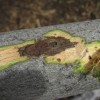 Thousand cankers disease of walnut is a tree disease of the edible nut-producing and ornamental tree, black walnut. The first diseased trees were observed in New Mexico in the 1990s. The disease has since spread to most of the western states. Until 2009, diseased black walnut trees were only found outside of the natural range of black walnut, which occurs from the mid-Atlantic states to just west of the Mississippi River. In 2009, it was found near Knoxville, Tennessee; it has since spread to Pennsylvania and Virginia. It is possible that within the next decade this disease could naturally spread to Florida. However, if people continue to move TCD infested walnut logs from place to place, this disease could arrive in Florida tomorrow. This 3-page fact sheet was written by Don Spence and Jason A. Smith, and published by the UF Department of School of Forest Resources and Conservation, February 2013.
Thousand cankers disease of walnut is a tree disease of the edible nut-producing and ornamental tree, black walnut. The first diseased trees were observed in New Mexico in the 1990s. The disease has since spread to most of the western states. Until 2009, diseased black walnut trees were only found outside of the natural range of black walnut, which occurs from the mid-Atlantic states to just west of the Mississippi River. In 2009, it was found near Knoxville, Tennessee; it has since spread to Pennsylvania and Virginia. It is possible that within the next decade this disease could naturally spread to Florida. However, if people continue to move TCD infested walnut logs from place to place, this disease could arrive in Florida tomorrow. This 3-page fact sheet was written by Don Spence and Jason A. Smith, and published by the UF Department of School of Forest Resources and Conservation, February 2013.
http://edis.ifas.ufl.edu/fr376